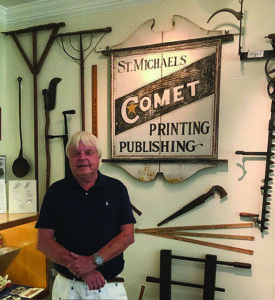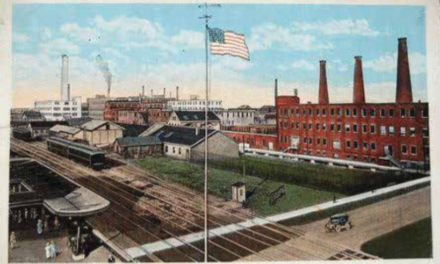(Editor’s note: DeeDee Wood is the owner of Black Cat Curiosities, an online antiques research and sales venue.)

Scott Hercik stands in front of some artifacts in the St. Michaels Museum. The items teach about local history, and are curated in an orderly fashion with documentation of each item with dates and historical facts. (Photos by DeeDee Wood)
Scott Hercik, vice president of the board of trustees for St. Michaels Museum, stands proudly in front of a wall of artifacts in the museum as his picture is taken.
This museum, nestled in quaint “St. Mary’s Square” in St. Michaels, Maryland, projects unique history, interesting artifacts on display from their collection, and a rich shared history of an interesting historic town. Scott had a lot to share about the history of the museum, the passion of the volunteers who work there, and the unique area in which the museum is located.
“Our museum reflects the history of this town, and the artifacts represent time periods of the town within that history,” he said, showing me around the museum.
The museum is situated on a piece of land where the high school in St. Mary’s Square once stood. (Steeped in history, St. Mary’s Square was once the bustling center of town in the early plans of St. Michaels.) Hercik explained that in the 1960s, the school was torn down when new schools in a different area of town were built to service more students, and the museum was then created on that piece of land.
“The museum is three structures,” he explained. “It is a residence formally owned by Jeremiah Sewell, the Chaney House and the Teetotum Building.
All three buildings are historic and were moved here from other locations in the area.”
As you tour the museum, you can find storyboards and view historic photos of Frederick Douglass, a social reformer, abolitionist, writer and statesman, who escaped from slavery in Maryland to become a national leader in the abolitionist movement.
A skilled orator and writer, Douglass is included in this museum’s history and narrative because he spent some time in his youth in St. Michaels, being born about 15 miles away.
The museum has an impressive diorama in the middle of the museum’s main gallery that showcases tiny ships, historic points and river inlets of the area, with lighted push buttons that indicated historic events on the “map” of the diorama. The vice president explained that it is one of the most popular items in the museum, due to its interactive nature.
Some of the collection materials and artifacts can be seen on the museum’s website, and can also be viewed in person.
Highlights include antique ship building tools, vintage signs of maritime heritage, photos and postcards from different eras, school girl samplers (one is from 1796), many different kinds of children’s toys and play items, oil portraits, furniture, nautical half models, full models, sailing items and more.
The artifacts in this museum are fascinating, teach about local history of the area, and are curated in an orderly fashion with documentation of each item with dates and historical facts.
Scott shared with me that President Jeff Fones and Chief Curator, Kate Fones, were very proud of the museum and take pride in its representation and display, as well as educating visitors about the rich and interesting history of St. Michaels.
Hercik also explained that the museum offers historic walking tours of the Town of St. Michaels.
The museum website states, “a guided walking tour is offered each Saturday at 10 a.m. Special tours may be scheduled at other times.”
There is also a self-guided walking tour map available outside the museum on their grounds, that offers visitors points of interest on a numbered map, as you stroll about town.
As a first time visitor to the museum, I felt a sense of going back in time as I toured each unique room, with local, donated artifacts from a forgotten era of a young town, portraits of people long gone, an entire second floor with a room dedicated to a sea captain portrait and unique toys, and a kitchen from long ago, with unique tools of cooking no longer seen.
A long hallway beckoned me at one point to peer at the antiques and artifacts mounted on the wall, woven wool blankets in purposeful patterns, made by hand on looms that are no longer used, (but carefully displayed for the modern viewer to imagine a time when they were.)
The St. Michaels Museum at St. Mary’s Square, located at 201 E. Chestnut Street, is open Fridays from 1-4 p.m., Saturdays from 10 a.m. to 4 p.m., and Sundays from 1-4 p.m., May 5 thru Oct. 29.
Admission is $5 for adults, but children 18 and younger enter for free. For more information, visit https://www.stmichaelsmuseum.org call 410-745-9561, or e-mail info@stmichaelsmuseum.org.




